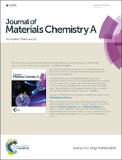Files in this item
Development of Novel Anode material for Intermediate Temperature SOFC (IT-SOFC)
Item metadata
| dc.contributor.author | Sinha, Amit | |
| dc.contributor.author | Miller, David Noel | |
| dc.contributor.author | Irvine, John Thomas Sirr | |
| dc.date.accessioned | 2017-08-15T08:44:14Z | |
| dc.date.available | 2017-08-15T08:44:14Z | |
| dc.date.issued | 2016-07-28 | |
| dc.identifier | 243605971 | |
| dc.identifier | ac644385-7210-49f6-85c3-fbcff999c8a6 | |
| dc.identifier | 84978912218 | |
| dc.identifier | 000379473100044 | |
| dc.identifier.citation | Sinha , A , Miller , D N & Irvine , J T S 2016 , ' Development of Novel Anode material for Intermediate Temperature SOFC (IT-SOFC) ' , Journal of Materials Chemistry A , vol. 4 , no. 28 , pp. 11117-11123 . https://doi.org/10.1039/C6TA03404G | en |
| dc.identifier.issn | 2050-7488 | |
| dc.identifier.other | ORCID: /0000-0002-8394-3359/work/68280809 | |
| dc.identifier.uri | https://hdl.handle.net/10023/11455 | |
| dc.description | We thank the Engineering and Physical Sciences Research Council (EPSRC)/ H2FC Supergen (EP/J016454/1, EP/K015540/1) and the Royal Society (WRMA 2012/R2) for support. | en |
| dc.description.abstract | The present work envisages application of titanium oxycarbide as a possible anode material for intermediate temperature solid oxide fuel cells (IT-SOFC). Titanium oxycarbide samples (TiOxC1-x with x = 0.2 - 0.8) were prepared by reaction-sintering of TiO and TiC powders under vacuum at 1500 C for 5 h. Basic studies on TiOxC1-x (x = 0.2-0.8) with respect to phase purity and stability under oxidizing and reducing environments were carried out. The compatibility of titanium oxycarbide with intermediate-temperature electrolyte material (Ce0.9Gd0.1O3-δ) was studied. The electrochemical properties of planar cells using Ce0.9Gd0.1O3-δ as electrolyte and employing TiO0.2C0.8 and La0.8Sr0.2Co0.2Fe0.8O3-δ based anode and cathode materials were investigated. | |
| dc.format.extent | 7 | |
| dc.format.extent | 1783107 | |
| dc.language.iso | eng | |
| dc.relation.ispartof | Journal of Materials Chemistry A | en |
| dc.subject | QD Chemistry | en |
| dc.subject | NDAS | en |
| dc.subject.lcc | QD | en |
| dc.title | Development of Novel Anode material for Intermediate Temperature SOFC (IT-SOFC) | en |
| dc.type | Journal article | en |
| dc.contributor.sponsor | EPSRC | en |
| dc.contributor.sponsor | EPSRC | en |
| dc.contributor.sponsor | EPSRC | en |
| dc.contributor.sponsor | The Royal Society | en |
| dc.contributor.sponsor | EPSRC | en |
| dc.contributor.institution | University of St Andrews. School of Chemistry | en |
| dc.contributor.institution | University of St Andrews. EaSTCHEM | en |
| dc.identifier.doi | https://doi.org/10.1039/C6TA03404G | |
| dc.description.status | Peer reviewed | en |
| dc.date.embargoedUntil | 2017-06-21 | |
| dc.identifier.grantnumber | EP/J02094X/1 | en |
| dc.identifier.grantnumber | EP/J016454/1 | en |
| dc.identifier.grantnumber | EP/K015540/1 | en |
| dc.identifier.grantnumber | WRMA 2012/R2 | en |
| dc.identifier.grantnumber | EP/J02094X/1 | en |
This item appears in the following Collection(s)
Items in the St Andrews Research Repository are protected by copyright, with all rights reserved, unless otherwise indicated.

